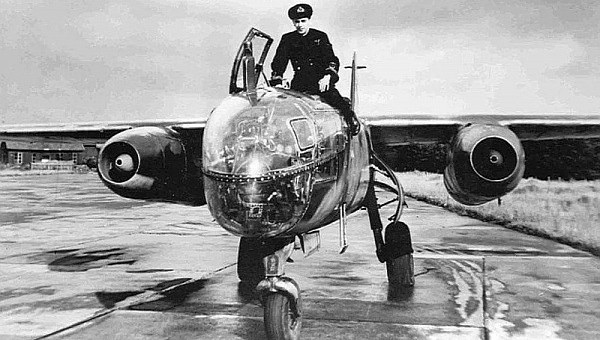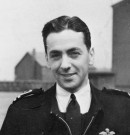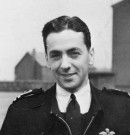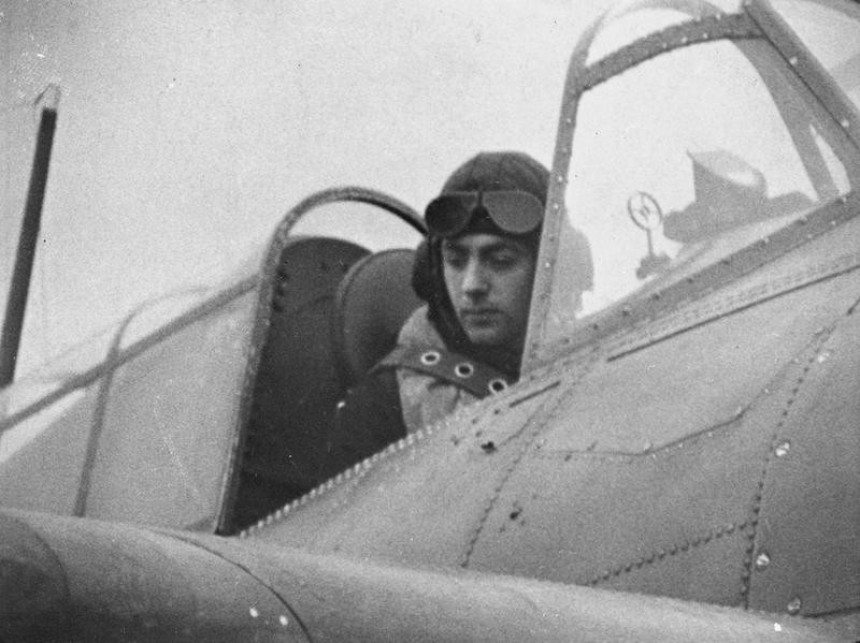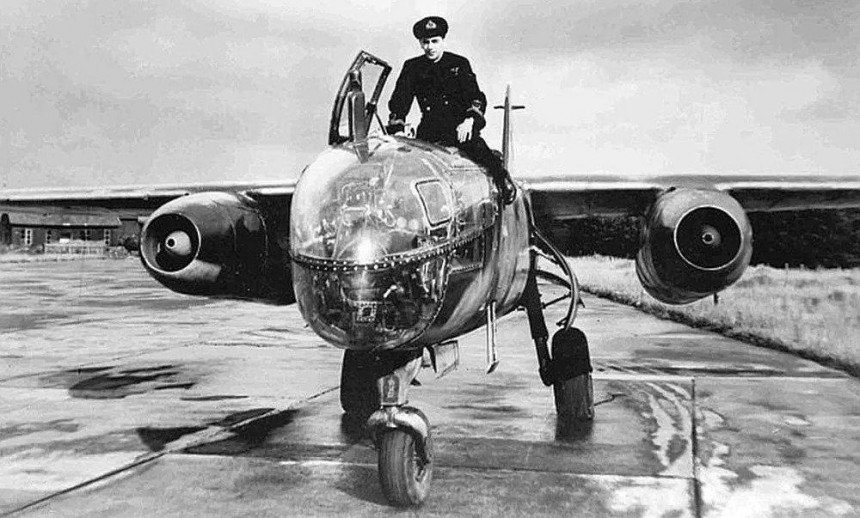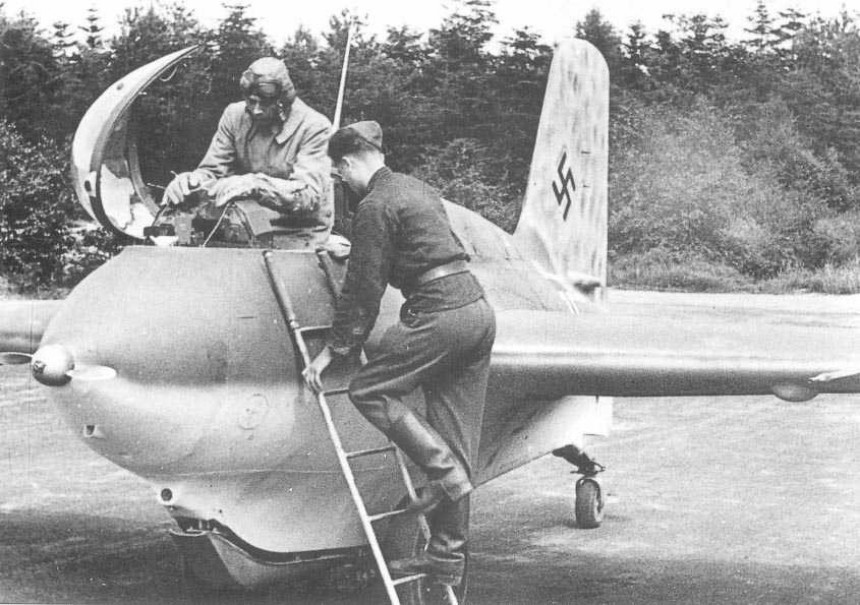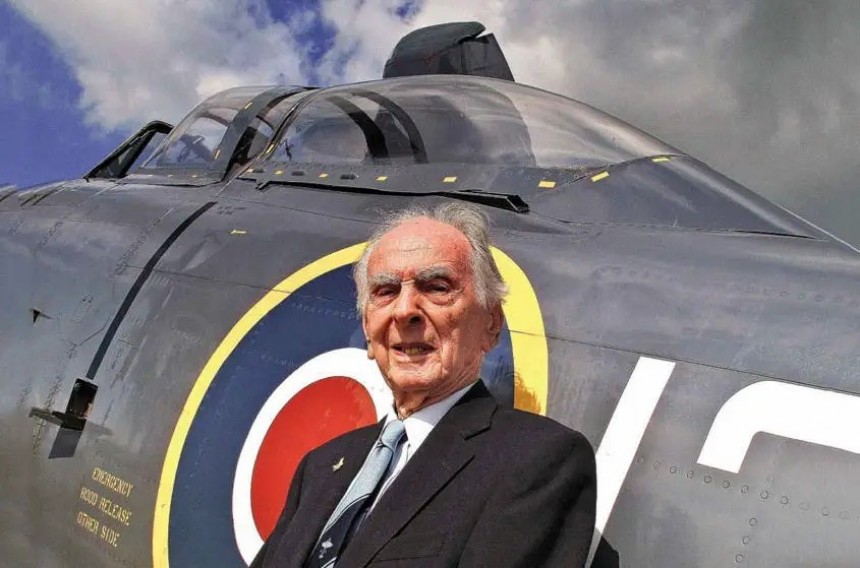If you ask modern petrolheads who they most want to walk in their shoes for a while, many will tell you it's none other than the YouTube automotive juggernaut Doug DeMuro. As of the early 2020s, Doug's reviewed between 300 and 400 bespoke car models for his YouTube page. But what if we told you there was someone out there with an even more impressive record.
How bonkers would it sound if a legendary British airman tested even more different airplanes than Papa Doug has cars? This is the story of Captain Eric "Winkle" Brown, the Guinness Book of Records holder for testing more airplanes than anyone else in history. Like Doug DeMuro, Eric Brown liked to make detailed notes of every plane he flew. In a sense, there's an argument that Eric Brown was put on this Earth to fly. He was born on January 21st, 1919, as the son of a Royal Flying Corps balloon observer in World War I.
As a man who enjoyed taking the young Eric on grand adventures around Europe, Eric Brown's first flight aboard a single-engined Gloster Gauntlet biplane only assured the boy's lifelong passion for flying was set in stone. In 1936, Brown's father accompanied him on a trip to Berlin for the 1936 Olympics. You know, the famous one where Adolf Hitler expected his genetically "pure" German competitors to trounce every other nation. Only to shake the American Jesse Owen's hand after he wiped the floor with everyone else.
This was a landmark event Brown himself was a witness to. All the while, at the same event, the head of the newly-announced German Luftwaffe, Herman Goring, was preparing his new German Air Force for some flight demonstrations during the games. At the same time, large social gatherings were organized by Luftwaffe personnel in the wake of the Olympics. At these gatherings, Luftwaffe staff encouraged foreign nationals to mingle and discuss flying with German officials.
It was as these gatherings were organized to determine the levels of apathy the British among them felt towards the Luftwaffe. Though no one in the U.K. knew it yet, this very same Luftwaffe would be dropping bombs on British cities less than five years later. In the meantime, a young Eric Brown was introduced to the legendary First World War German fighter ace Ernst Udet at one of these gatherings. Soon afterward, Brown was riding shotgun as Udet flew him around in a Bücker Bü 131 Jungmann military trainer.
The experience affected Eric Brown profoundly, to the point where he applied for an Anglo-German exchange student program to which he was dually accepted. Before long, Brown was speaking German fluently and also realizing the Luftwaffe, which only a few years ago would've been illegal, was starting to get awfully big. While there, Brown met and became friends with the world-famous German aviator Hanna Reitsch.
Eric Brown was a personal witness to Reistch's demonstrator flights in the novel Focke-Wulf Fw 61, the world's first working practical helicopter. The pointers Hanna Reitsch instilled in him about the particulars of flying helicopters would come in handy for the man later in life. Lo and behold, September 1939 comes around, and Eric Brown hears a knock at his door.
It was the SS, there to tell Brown their two respective countries were at war and that he was now under arrest. After three days sitting in jail, Brown was escorted in his MG N-Type Magnette drop-top sports car to the Swiss border. Just like that, the Germans allowed the future most distinguished British test pilot to slip right through their fingers. Soon after his return to Britain, Brown joined the Royal Navy's Volunteer Reserve as Fleet Air Arm Pilot of the 802 Naval Air Squadron aboard the carrier HMS Audacity.
It was here where Eric Brown was introduced for the first time to a whole new breed of warbirds, American ones. It was while serving aboard the Audacity that Brown first flew the Grumman Martlet, a license-operated variant of the Grumman F4F Wildcat. Brown even managed to down two Focke-Wulf Fw-200 Condor bombers while flying Martlets. Even when Brown's home ship was destroyed by U-Boat torpedoes, he continued flying afterward.
Many of Brown's shipmates wouldn't survive the U-Boat attack. Quite a few sailors succumbed to hypothermia before the German submarine evacuated the area allowing rescue to finally arrive. It was only after being seconded to the Royal Canadian Air Force escorting American B-17 Flying Fortress bombers for a while that Eric Brown was transferred to the Royal Aeronautical Establishment. It was here where Brown was tasked to test his first experimental airplane, a prototype Fairey Barracuda torpedo bomber.
It was Brown's first taste of the test pilot life, one he attempted to satiate for the rest of his military career. Soon after, Brown was transferred to Southern Italy. Here, he received real-time instructions on the operating procedures for captured Italian and German warplanes for the purpose of flight testing. So impressed was Brown's commander with his flight work that he recommended the young pilot fly back to England to test airplanes on a more permanent basis.
It was at this time that Eric Brown began his transformation from your average plucky British pilot to the Doug DeMuro of the skies. In his first month at his new job as a test pilot at the Royal Aircraft Establishment in Farnborough, Hampshire, Brown tested 13 different captured and experimental airplanes. Hailing from nations like Britain, Italy, and Germany, this included a captured Focke-Wulf Fw 190 fighter.
While trialing the Supermarine Seafire and Hawker Sea Hurricane, Eric Brown became one of the most prolific carrier-landing experts in all the Allied force's arsenal. By the end of 1943, Brown had completed as many as 1,500 aircraft carrier landings on 22 different Allied warships. By the end of his career, that number would increase to 2,407 carrier landings. Brown's exploits flying both single and twin-engine warplanes were so renowned even the Americans offered to give him seat time in their own airplanes.
During his time assisting the American Eighth Air Force under the command of the iconic General Jimmy Doolittle, Eric Brown familiarized himself with the three pre-eminent American prop-fighters. Between the Republic P-47 Thunderbolt, the Lockheed P-38 Lightning, and the North American P-51 Mustang, only one could be chosen to take on the bulk of America's fighter escort service for American daylight strategic bombing campaigns.
Brown found all three airplanes to be nothing short of fantastic in their own ways. But the Mustang was by far the most suited for daytime bomber escort. By February 1945, Brown had an encounter with a machine he'd not seen since his days in Germany with Hanna Reitsch, a freshly built Sikorsky R4 helicopter known as the Hoverfly in RAF service. Though the R4 was not an easy aircraft to fly, Brown soon became one of the leading experts in helicopter flight dynamics in all of Britain.
Amazingly, captured German V2 missile technology was considered for a time to be adopted for sub-orbital spaceflight use by the Royal Air Ministry. Had the design, dubbed the Megaroc, been built, Eric Brown was on the short list of candidates for the first human being to fly in space as early as 1949. That's a full 11 years before Yuri Gagarin's first trip to space in 1961.
Being such a primitive booster rocket and with such a poor understanding of rocket mechanics at the time, the Megaroc would have likely been a death trap. Thankfully then, the project was canceled before Brown could risk his life trying to fly the thing. Instead, Eric Brown kept busy pushing civilian planes like the Avro Tudor airliner up to a blistering 70 percent the speed of sound. Either that or test flying the breadth of captured German experimental airplanes like the Me-163 rocket interceptor and the Dornier Do-335. That's on top of flying each of the three German jet aircraft deployed before the end of the war.
Speaking of the sound barrier, Brown planned on smashing this boundary as well. Had the Miles M.52 been greenlit, it could have broken the sound barrier officially for the first time a full calendar year before Chuck Yeager managed the feat behind the stick of the Bell X-1. Around the same time, Brown began test-flying what he considered one of his all-time favorite piston fighters, the de Havilland Hornet. Though already familiar with the prerequisite Mosquito, Brown found the Hornet to be like a hot rod Mosquito.
During the Korean War, Brown began a two-year exchange program with the United States stationed at Naval Air Station Patuxent River in St. Mary's County, Maryland. While there, Brown introduced U.S. Navy airmen to a novel form of aircraft carrier steam catapults far more powerful than the hydraulics of the day. Behind the stick of a Grumman F9F Panther, Eric Brown did what he did best, taking off from the HMS Perseus still docked in the Philadelphia Naval Yard.
Brown's career as a test pilot was one without equal. Among all the British, German, American, Soviet, Japanese, Brazilian, and Canadian aircraft he flew in his day, Eric Brown was estimated as test flying at least 487 different types of aircraft. No matter the shape, size, number of engines, prop or jet-powered, Eric Brown did it all.
Had the internet and cell phone cameras been around in those days, Brown could have made a killing by turning his exploits into the world's best aviation vlog. Eric Brown retired from the RAF in 1970 and died aged 97 on February 21st, 2016.
Godspeed, Captain Brown. Your career will probably never be touched in scale by another human being ever again.
As a man who enjoyed taking the young Eric on grand adventures around Europe, Eric Brown's first flight aboard a single-engined Gloster Gauntlet biplane only assured the boy's lifelong passion for flying was set in stone. In 1936, Brown's father accompanied him on a trip to Berlin for the 1936 Olympics. You know, the famous one where Adolf Hitler expected his genetically "pure" German competitors to trounce every other nation. Only to shake the American Jesse Owen's hand after he wiped the floor with everyone else.
This was a landmark event Brown himself was a witness to. All the while, at the same event, the head of the newly-announced German Luftwaffe, Herman Goring, was preparing his new German Air Force for some flight demonstrations during the games. At the same time, large social gatherings were organized by Luftwaffe personnel in the wake of the Olympics. At these gatherings, Luftwaffe staff encouraged foreign nationals to mingle and discuss flying with German officials.
It was as these gatherings were organized to determine the levels of apathy the British among them felt towards the Luftwaffe. Though no one in the U.K. knew it yet, this very same Luftwaffe would be dropping bombs on British cities less than five years later. In the meantime, a young Eric Brown was introduced to the legendary First World War German fighter ace Ernst Udet at one of these gatherings. Soon afterward, Brown was riding shotgun as Udet flew him around in a Bücker Bü 131 Jungmann military trainer.
Eric Brown was a personal witness to Reistch's demonstrator flights in the novel Focke-Wulf Fw 61, the world's first working practical helicopter. The pointers Hanna Reitsch instilled in him about the particulars of flying helicopters would come in handy for the man later in life. Lo and behold, September 1939 comes around, and Eric Brown hears a knock at his door.
It was the SS, there to tell Brown their two respective countries were at war and that he was now under arrest. After three days sitting in jail, Brown was escorted in his MG N-Type Magnette drop-top sports car to the Swiss border. Just like that, the Germans allowed the future most distinguished British test pilot to slip right through their fingers. Soon after his return to Britain, Brown joined the Royal Navy's Volunteer Reserve as Fleet Air Arm Pilot of the 802 Naval Air Squadron aboard the carrier HMS Audacity.
It was here where Eric Brown was introduced for the first time to a whole new breed of warbirds, American ones. It was while serving aboard the Audacity that Brown first flew the Grumman Martlet, a license-operated variant of the Grumman F4F Wildcat. Brown even managed to down two Focke-Wulf Fw-200 Condor bombers while flying Martlets. Even when Brown's home ship was destroyed by U-Boat torpedoes, he continued flying afterward.
It was Brown's first taste of the test pilot life, one he attempted to satiate for the rest of his military career. Soon after, Brown was transferred to Southern Italy. Here, he received real-time instructions on the operating procedures for captured Italian and German warplanes for the purpose of flight testing. So impressed was Brown's commander with his flight work that he recommended the young pilot fly back to England to test airplanes on a more permanent basis.
It was at this time that Eric Brown began his transformation from your average plucky British pilot to the Doug DeMuro of the skies. In his first month at his new job as a test pilot at the Royal Aircraft Establishment in Farnborough, Hampshire, Brown tested 13 different captured and experimental airplanes. Hailing from nations like Britain, Italy, and Germany, this included a captured Focke-Wulf Fw 190 fighter.
While trialing the Supermarine Seafire and Hawker Sea Hurricane, Eric Brown became one of the most prolific carrier-landing experts in all the Allied force's arsenal. By the end of 1943, Brown had completed as many as 1,500 aircraft carrier landings on 22 different Allied warships. By the end of his career, that number would increase to 2,407 carrier landings. Brown's exploits flying both single and twin-engine warplanes were so renowned even the Americans offered to give him seat time in their own airplanes.
Brown found all three airplanes to be nothing short of fantastic in their own ways. But the Mustang was by far the most suited for daytime bomber escort. By February 1945, Brown had an encounter with a machine he'd not seen since his days in Germany with Hanna Reitsch, a freshly built Sikorsky R4 helicopter known as the Hoverfly in RAF service. Though the R4 was not an easy aircraft to fly, Brown soon became one of the leading experts in helicopter flight dynamics in all of Britain.
Amazingly, captured German V2 missile technology was considered for a time to be adopted for sub-orbital spaceflight use by the Royal Air Ministry. Had the design, dubbed the Megaroc, been built, Eric Brown was on the short list of candidates for the first human being to fly in space as early as 1949. That's a full 11 years before Yuri Gagarin's first trip to space in 1961.
Being such a primitive booster rocket and with such a poor understanding of rocket mechanics at the time, the Megaroc would have likely been a death trap. Thankfully then, the project was canceled before Brown could risk his life trying to fly the thing. Instead, Eric Brown kept busy pushing civilian planes like the Avro Tudor airliner up to a blistering 70 percent the speed of sound. Either that or test flying the breadth of captured German experimental airplanes like the Me-163 rocket interceptor and the Dornier Do-335. That's on top of flying each of the three German jet aircraft deployed before the end of the war.
During the Korean War, Brown began a two-year exchange program with the United States stationed at Naval Air Station Patuxent River in St. Mary's County, Maryland. While there, Brown introduced U.S. Navy airmen to a novel form of aircraft carrier steam catapults far more powerful than the hydraulics of the day. Behind the stick of a Grumman F9F Panther, Eric Brown did what he did best, taking off from the HMS Perseus still docked in the Philadelphia Naval Yard.
Brown's career as a test pilot was one without equal. Among all the British, German, American, Soviet, Japanese, Brazilian, and Canadian aircraft he flew in his day, Eric Brown was estimated as test flying at least 487 different types of aircraft. No matter the shape, size, number of engines, prop or jet-powered, Eric Brown did it all.
Had the internet and cell phone cameras been around in those days, Brown could have made a killing by turning his exploits into the world's best aviation vlog. Eric Brown retired from the RAF in 1970 and died aged 97 on February 21st, 2016.
